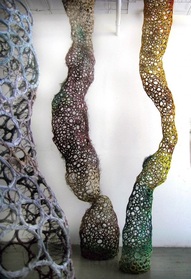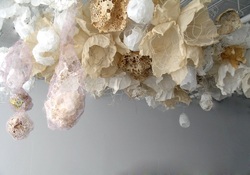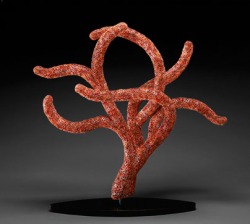
oooooh I have found her website.... take a look....
http://karenmargolisart.com/Karen/Intro.html

| Poppiloops |
|
 Love love LOVE this artist!! Again spotted an image previously now mooching for more info!! Enjoy! oooooh I have found her website.... take a look.... http://karenmargolisart.com/Karen/Intro.html  This stunning sculpture, Continuum, was created by artist Karen Margolis. The clusters of pods and tulip-like shapes are made from maps and handmade papers. If you look closely in the photos, you'll see the incredible textured effects of a soldering iron. I have to say that those are the most beautiful burn holes I've ever seen!
0 Comments
Still looking for a little info on Katy Usvitsky after spotting her in an exhibition (blogged below) but here are some images I have found so far......
Now here is an exhibition that I wish I could have gone to see!! Check these beauties out!
Curated by Lovina Purple, the show examines artwork that has been created in traditional craft techniques such as weaving, quilting, lace-making, knitting and embroidery. The exhibition features works by artists Elisa D’Arrigo, Karen Margolis, Christina Massey, Hyo Jeong Nam, Gail Rothschild, and Katya Usvitsky. http://www.escapeintolife.com/press-release-exhibit-art-show/knot-your-average-knit/ Now it is times like these that I am so glad I am a moocher! When I come across an artist making such beautiful intricate pieces such as these.... Kait Rhoads brings a BFA in glass from Rhode Island School of Design, MFA in glass from Alfred University, high level of skill, respect for traditional glass techniques, affinity for fiber based knot tying and background in painting to her beautiful glass, copper and steel Soft sculpture series. Extremely labor intensive, the work eloquently expresses her appreciation for underwater plant and animal life. http://www.kaitrhoads.com Rhoads spent 300 hours weaving the murrine pieces in Red Polyp (pictured below). You can see the process here.  Red Polyp, 45″ high x 46″ wide x 19″ deep
Blown glass, mixed red hollow murrine woven with copper wire “The soft sculpture and other woven pieces composed of hollow murrine are created through a labor-intensive process. Using a steel hexagon-shaped mold, I blow different colored glass bubbles and pull them out into a hollow rod shape. These rods are cooled, annealed, and then cut into small, beadlike pieces either by hand or with a diamond saw. Finally, the beads are heated in a kiln to soften their edges. This step tapers them slightly, making it easier to create a flowing curve when I weave them together with copper wire.” Kait Rhoads |